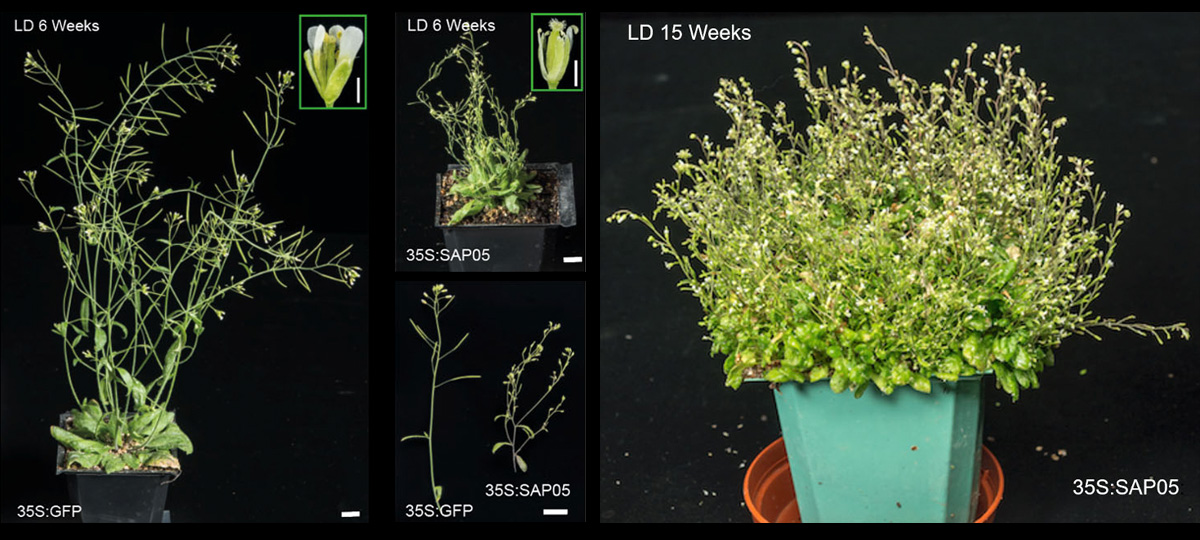
John Innes Centre Research Group Identifies Microbial Molecule that Turns Plants into Zombies
September 22, 2021| |
Researchers from the Hogenhout group at the John Innes Centre and their collaborators have identified a manipulation molecule produced by Phytoplasma bacteria to hijack plant development. Inside a plant, this protein causes the breakdown of key growth regulators, triggering abnormal growth.
Phytoplasma are microbes that are notorious for their ability to reprogram their host plants' development. This group of bacteria is often responsible for the excessive number of branches in trees grown close together called ‘witches' brooms'. These bushy outgrowths are the result of the plant being stuck in a vegetative "zombie" state, unable to reproduce, and therefore progress to a ‘forever young' status. Phytoplasma bacteria also cause devastating crop diseases in grain and leaf crops such as lettuce, carrots, and cereals.
The research shows that the bacterial protein SAP05 manipulates plants by taking advantage of some of its own molecular machinery. This machinery, called the proteasome, breaks down proteins that are no longer needed inside plant cells. SAP05 then hijacks this process, causing plant proteins that are important in regulating growth and development to effectively be thrown in a molecular recycling center. Without these proteins, the plant's development is reprogrammed to favor the bacteria, triggering the growth of multiple vegetative shoots and tissues and putting the pause on plant aging.
The team uncovered in detail the role of SAP05 and found that the protein binds directly to both the plant developmental proteins and the proteasome. The research also allowed the team to pinpoint two amino acids in the proteasome that are needed to interact with SAP05. If the plant proteins are switched to have the two amino acids, they are no longer degraded by SAP05, preventing the ‘witches' broom' abnormal growth.
For more details, read the article on the John Innes Centre website.
| |
You might also like:
- Scientists Shed Light on Molecular Mechanisms of Bacterial Plant Disease
- JIC Scientists Study How Parasites Modify Plants to Attract Insects
- Fighting to Save the 'Tree of Life'
Biotech Updates is a weekly newsletter of ISAAA, a not-for-profit organization. It is distributed for free to over 22,000 subscribers worldwide to inform them about the key developments in biosciences, especially in biotechnology. Your support will help us in our mission to feed the world with knowledge. You can help by donating as little as $10.
-
See more articles:
-
News from Around the World
- Asian Regional Workshop on Current and Upcoming Items under the CBD and its Protocols
- Biotech Stakeholders Gather to Celebrate Africa Biotechnology Gains at ABBC2021
- Statements by Known Organizations Influence Consumer's Attitude about GMOs
- US Scientists Embark on Developing Edible Plant-based Vaccines
- Australian OGTR Approves Commercial Release of GM Canola
- Australian Researchers Discover Barley Powdery Mildew Resistance Genes
- John Innes Centre Research Group Identifies Microbial Molecule that Turns Plants into Zombies
- French Researchers and Experts Appeal to President Macron to Support Plant Biotechnologies
-
Research Highlights
- Scientists Assess Impact of Beta-carotene-enriched Soybeans on Soil Microorganisms
-
Plant
- CRISPR-dMac3-Cas9 System Used to Investigate Potato Tuber Starch Trait
- Researchers Identify Abiotic Stress Tolerance Genes for Editing in Upland Rice
- Japan Starts Sale of Genome-Edited High-GABA Tomato
-
Read the latest: - Biotech Updates (December 10, 2025)
- Gene Editing Supplement (December 17, 2025)
- Gene Drive Supplement (February 22, 2023)
-
Subscribe to BU: - Share
- Tweet

